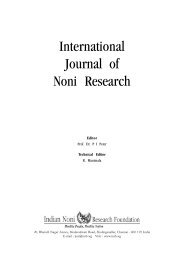International Journal of Noni Research - Noni Family
International Journal of Noni Research - Noni Family
International Journal of Noni Research - Noni Family
Create successful ePaper yourself
Turn your PDF publications into a flip-book with our unique Google optimized e-Paper software.
5 Intl. J. <strong>Noni</strong> Res. 2007, 2(1-2)<br />
P. Rethinam et al. <strong>Noni</strong> (Morinda citrifolia L.) - the Miracle Fruit - a holistic review<br />
plant parts are used in the treatment <strong>of</strong> various diseases and disorders. The<br />
fruit is important because <strong>of</strong> its wide range <strong>of</strong> therapeutic potentials such as<br />
anti-bacterial, anti-viral, anti-tumor, anti-helminthes, analgesic, hypertensive,<br />
anti-inflammatory and immune enhancing effects. Use <strong>of</strong> <strong>Noni</strong> fruit juice from<br />
unripe or ripe fruit<br />
is a more recent innovation and is recently accepted in the European Union<br />
as a novel food. The roots are being used to synthesize red dye while the<br />
leaves, bark, and fruits are used to produce facial creams, soaps, toothpaste,<br />
lotions, tea powder and various other products. Abbott (1992) reported that<br />
<strong>Noni</strong> has been used as drink, food, medicine and dye. In the past decade<br />
the global popularity <strong>of</strong> <strong>Noni</strong> has increased dramatically (Dixon et. al.,1999<br />
and Clatchey, 2002). There are many <strong>Noni</strong> based products like health<br />
products, home care products, ,food products, health support products, fruit<br />
drinks, cosmetics like body care, oral line, face line, hand line, feet line etc.,<br />
(Vigneshwari and Peter, 2007).<br />
Common Names In India<br />
Tamil - Nuna, Manjanathi, Manjanuna, Telugu-Bandamaddi, Maddicettu, Mogali,<br />
Molugu ,Malayalam-Kakai palam, Kattapitalavam,Mannanatti, Kanada-<br />
Haladipavete, Tagatemara, Hindi- Ach, Awl, Sanskrit-Ach, Paphanah, Achchhuka,<br />
Marathi- Aseti, Nagkura, Mundari, Salidaru.<br />
Local names for Morinda citrifolia L<br />
It is known in different names locally as Cheese Fruit, Forbidden Fruit,<br />
Headache Tree, Hog Apple, Mona, Mora de la India, Nino, Nona, Nono,<br />
Nonu, Nuna, Pain Bush, Pain Killer Tree, Pinuela, Wild Pine, etc. in various<br />
parts <strong>of</strong> the world. It is also called as Indian Mulberry (Mathivanan et. al.,<br />
2005).<br />
Distribution <strong>of</strong> Morinda<br />
The species is generally found from sea level to 400 m above MSL, although<br />
it adapts better to coastal regions (Lu¨ berck and Hannes, 2001). <strong>Noni</strong> is an<br />
evergreen tree and is <strong>of</strong>ten found growing along lava flows. Bulk <strong>of</strong> the crop<br />
is wild and adapts to hardy environment and soil conditions. It can be found<br />
naturally in disturbed forests, alien grass lands, open areas near the shore<br />
lines, pastures, coconut plantations, littoral forests, fallow areas and in waste<br />
lands (Cambie and Ash, 1994). The genus Morinda is distributed worldwide<br />
with 80 species reported so far, predominantly in tropical countries. It occurs<br />
in Africa, Australia, Barbados, Cambodia, Caribbean, Cayman Islands, Cuba,








